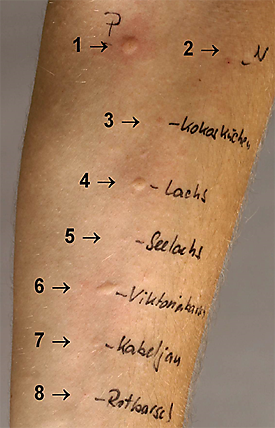Joint press release by the UFZ and the University Medical of 11 December 2013:
Each food fish can cause specific allergies
Research into protein provides new insight into fish allergies
Leipzig. Food allergies are evidently much more specific than previously assumed. More precise tests may allow allergy sufferers more freedom of food choice in the future. This is the result of studies carried out by the Helmholtz Centre for Environmental Research (UFZ), the University of Leipzig and the Haukeland University Hospital in Bergen. The researchers examined patients with a Nile perch allergy. Being allergic to Nile perch does not mean also being allergic to cod. Furthermore, species-specific allergens were identified that may help to improve avoidance strategies against such food allergies and make them more specific, the researchers write in the scientific journal Journal of Investigational Allergology and Clinical Immunology (JIACI).

One of the subjects of the study was a chef who had developed an allergy to Nile perch (Lates niloticus) after having come into contact with the raw fish following consumption of salmon (Salmo salar)
Photo: HLPhoto/Fotolia

Being allergic to Nile perch does not mean also being allergic to cod. Furthermore, species-specific allergens were identified that may help to improve avoidance strategies against such food allergies and make them more specific.
Photo: Marcus Karsten/Uniklinik Leipzig
Fish is one of the most important foods worldwide. It is considered healthy, due to international fish trade it is obtainable everywhere and it is therefore consumed in increasing amounts. In the industrialised countries around 28 kilograms of fish is now consumed per capita and year, and the trend is on the increase. The rising supply and demand for seafood is associated with an increased risk of fish allergies. The most common allergen in fish and crustaceans is parvalbumin, a calcium-binding protein. Other substances, however, are also suspected triggers of allergies, such as a group of proteins in cell metabolism called aldehyde dehydrogenases. It is possible that some of these proteins have been overlooked because they are overshadowed by the more frequent parvalbumin and have therefore been underestimated until now.
The most direct way of identifying new allergens is through analysing the serum of affected patients and the proteins of the allergy source. If the IgE antibodies in the patients’ serum bind to the proteins of the food that triggers the allergy, this is a clear signal. The identified allergies can initially be used for individual diagnoses and later for epidemiological studies, to determine the relevance of individual allergies. In their study, the researchers examined two patients from the University Hospital Leipzig and ten from the Haukeland University Hospital in Bergen in Norway. One of the subjects was a 24-year-old chef from Leipzig who had developed an allergy to Nile perch (Lates niloticus) after having come into contact with the raw fish following consumption of salmon (Salmo salar). Scientists know about such cross allergies. What was unusual about this case was that the patient tolerated other types of fish. Tests indicated signs of allergies to Nile perch and salmon, but not to Atlantic cod (Gadus morhua). “The tests that are currently used are very non-specific. For some people who suffer from fish allergies there may be hope of finding a fish that they can tolerate if we managed to make the relevant tests suitable for mass implementation and use them in allergy diagnostics”, says Dr Janina Tomm from the UFZ, who specialises in research into proteins.
The researchers report a similar case in a second publication. They examined proteins of the Kuruma shrimp (Marsupenaeus japonicus); they found two new enzymes, pyruvate kinase and phosphopyruvate hydratase, that could be the cause of food allergies to shellfish. In theory, both would only have a low allergenic potential. “This shows us that even though we are significantly better at predicting allergies, computer algorithms can currently not replace biochemical experiments”, emphasises University professor Jan-Christoph Simon. Here, too, detailed knowledge about hitherto underestimated allergens could help make the correct diagnosis in cases of shellfish allergies in the future.
Die Allergieuntersuchungen sind Teil des Leipziger Forschungszentrums für Zivilisationserkrankungen (LIFE), einem Großforschungsprojekt der Medizinischen Fakultät der Universität Leipzig im Rahmen der Landesexzellenzinitiative des Freistaates Sachsen
in Zusammenarbeit mit verschiedenen Kooperationspartnern wie dem UFZ. Dank der LIFE-Unterstützung konnte an der Klinik für Dermatologie und Allergologie bei Prof. Simon eine Nachwuchsgruppe für die Erkennung neuartiger Allergien eingerichtet werden.
Tilo Arnhold
Publications
JM Tomm, T van Do, C Jende, JC Simon, R Treudler, M von Bergen, M Averbeck (2013): Identification of New Potential Allergens From
Nile Perch (Lates niloticus) and Cod (Gadus morhua). J Investig Allergol Clin Immunol 2013; Vol. 23(3): 159-167.
http://www.jiaci.org/issues/vol23issue3/4.pdf
JM Tomm, C Krause, JC Simon, R Treudler, M von Bergen, M Averbeck (2013): Pyruvate Kinase and Phosphopyruvate Hydratase as Novel IgE Reactive Proteins in Prawn. J Investig Allergol Clin Immunol 2013; Vol. 23(6): 000-000
The studies were supported by the Leipzig Research Center for Civilization Diseases (LIFE) and funded by the European Union, the European Social Fund and the excellence initiative of the Free State of Saxony.
Further information:
Dr. Janina Tomm/
Prof. Dr. Martin von Bergen
Helmholtz Centre for Environmental Research (UFZ)
Phone: +49-341-235-1819, -1211
http://www.ufz.de/index.php?de=17566
http://www.ufz.de/index.php?de=17634
and
Prof. Dr. med. Jan-Christoph Simon
Director of the Clinic for Dermatology, Venerology and Allergology, University Clinic of Leipzig
Phone +49-341-97-18600
Prof. Dr. med. Jan-Christoph Simon
or via
Tilo Arnhold / Susanne Hufe (UFZ-press office)
Phone: +49-341-235-1630
presse@ufz.de
Further Links:
LIFE – Leipzig Research Center for Civilization Diseases
http://life.uni-leipzig.de/en/life_health_care_study.html
At the Helmholtz Centre for Environmental Research (UFZ) scientists are interested in the wide-ranging causes and impacts of environmental change. They conduct research on water resources, biodiversity, the impacts of climate change and adaptation strategies, environmental and biotechnologies, bioenergy, the behaviour of chemicals in the environment and their effects on health, modelling and sociological issues. Their guiding motto: our research serves the sustainable use of natural resources and helps towards long-term food and livelihood security in the face of global change. The UFZ has over 1,100 employees working in Leipzig, Halle und Magdeburg. It is funded by the federal government, as well as by the State of Saxony and Saxony Anhalt.
The Helmholtz Association contributes to finding solutions for large and pressing issues in society, science and the economy through excellence in the following six areas of research: energy, earth and the environment, health, key technologies, structure of matter, transport and aerospace. With almost 35,000 employees and coworkers in 18 research centres and an annual budget of approx. 3.8 billion Euros the Helmholtz Association is the largest scientific organization in Germany. Work is conducted in the tradition of the renowned natural scientist Hermann von Helmholtz (1821-1894).
